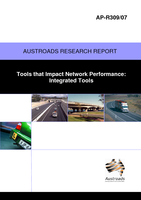Network

Tools that Impact Network Performance: Integrated Tools
- Publication no: AP-R309-07
- ISBN: 978-1-921329-16-6
- Published: 1 October 2007
- PDF (free) Download
Integrated tools can be a toolbox of technologies and procedures which combine both hard engineering methods such as the use of shoulders and lane access controls as well as dynamic traffic management tools such as ramp meters, incident detection, variable speed limits, changeable signage and traveller information. The response of road users to such tools will also play a significant factor in successful implementation. This report, on integrated tools for network performance, reviews how combinations of the tools that have been reviewed previously could work together at the network level. The deployment of integrated tools is relatively new for many road authorities and has so far been used exclusively on freeway corridors. A recently commissioned $100m project in Melbourne will be the first example of an integrated approach in Australia. There will be much to learn from this project and also a need for greater cooperation and collaboration across road agencies worldwide to share their experiences. Many practitioners are already thinking and recognising the importance of integrated operations and tools to improve overall network performance. Much more will be written on this subject but field experience in the form of pilots and demonstration projects will ultimately be the only means from which to build upon and develop integrated tools further.
- AP-R309/07 Tools that Impact Network Performance: Integrated Tools
- 1. INTRODUCTION
- 1.1. Project Brief
- 1.2. Objectives
- 1.3. Fit with Other Austroads Projects
- 1.4. Structure of the Report
- 2. BACKGROUND
- 2.1. Managing vs Building Roads
- 2.2. Dealing with Congestion
- 2.3. Australian Experience
- 2.4. Incident Management
- 3. INTEGRATED OPERATIONS
- 3.1. Sustainable Traffic Management
- 3.2. Active Traffic Management
- 3.3. German Integrated System
- 3.4. Integrated Corridor Management
- 3.5. VicRoads M1 Project
- 3.6. Freeway and Arterials
- 3.7. Information Sharing and Distribution
- 4. OTHER TRAFFIC NETWORKS
- 4.1. Water
- 4.2. Communications/IP Transmission
- 4.3. Air Traffic Control
- 4.4. Electricity
- 5. FINDINGS AND CONCLUSIONS
- 5.1. Findings
- 5.2. Workshop with Project Reference Group
- 5.3. Conclusions
- REFERENCES
Related publications
WEB-GADA-24
WEB-PROJECTS-23
Latest Network News
